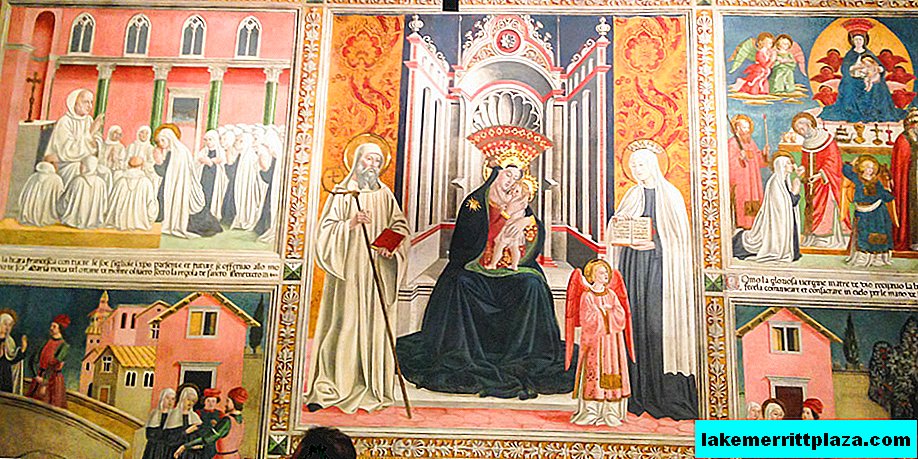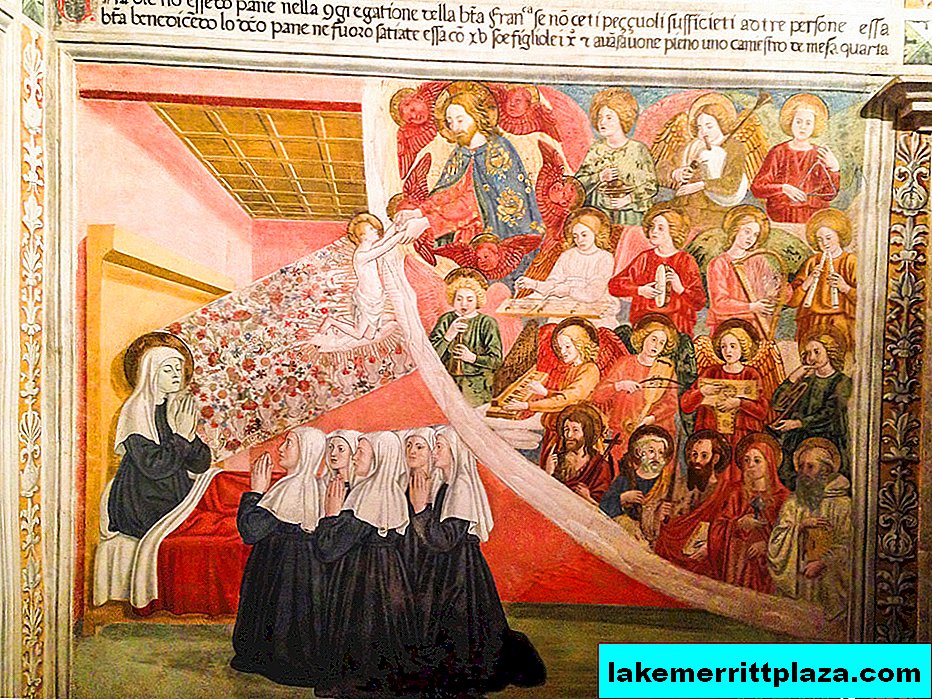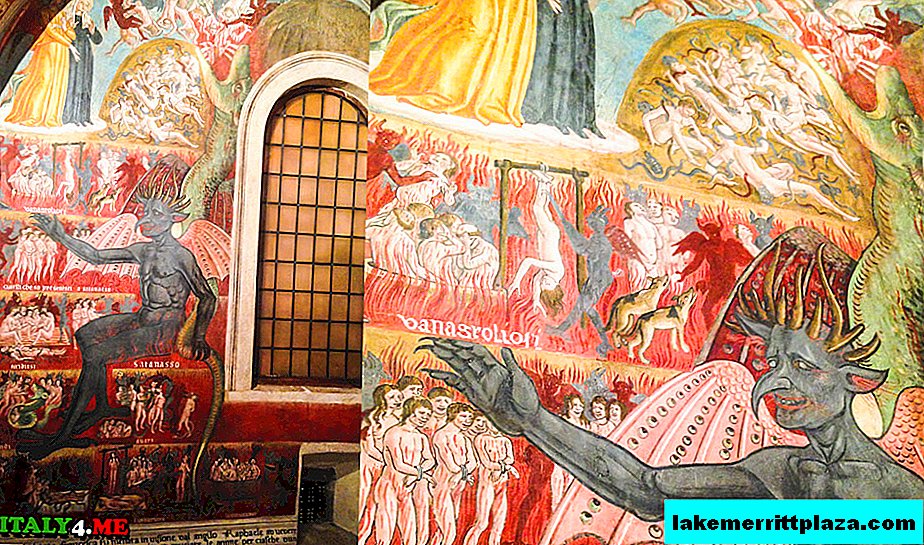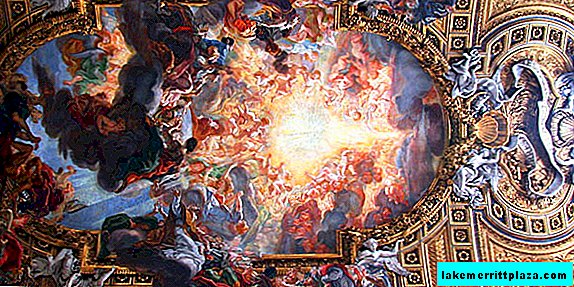Those who were in Rome for the March holidays had (and will be next year) a unique opportunity to visit one of the most secluded corners of the city. This is the monastery of Tor de Speccy (Tor de 'Specchi), which is opened only once a year, on March 9. Under the slopes of Capitoline Hill, near the ruins of the ancient Marcellus Theater (Teatro di Marcello), a long brown building is not immediately apparent. And not many people know what miracles it hides, passing by every day.
Therefore, already in the morning, residents of the city queue at the entrance to have time to see with their own eyes all the beauty hidden behind the harsh brick walls of the 15th century. Why is this monastery so famous?
It is all about the unusual life story of the most revered Roman saint, Francesca Ponziani, who founded this convention 5 centuries ago.

Urbis lawyer, defender of the city, beggar from Trastevere - she had many nicknames, but all of them pointed to the difficult fate of a woman who performed many miracles and experienced hardships to help those in need, entering the history of the city as Saint Francesca Roman.

Fragments of her life are still captured in the colorful frescoes of the school of Antoniazzo Romano on the ancient walls of the monastery.
The path from wealth to holiness
Beloved by the Romans, Saint Francesca was born in 1384 in a wealthy family of the nobleman Paolo Buss and his wife Jacobella Roffredeschi, whose house was on Piazza Navona.
A full chronicle of her life, visions and suffering came to us from the texts of don Giovanni Mattiotti, head of the church of St. Mary in Trastevere, whom Francesca trusted her confession for many years. Interestingly, they were written in the ancient Roman dialect Romanesco of the 15th century, a rarity in the archives!
A pretty girl, whom the family affectionately called Checcolella, from a young age showed seriousness and thoughtfulness unusual for children. She preferred solitary games with peers to solitude in her room and reading the life of the saints or "Divine Comedy." She soon felt a craving for the Church, and by the age of ten she had decided to become a nun and devote her life to prayer and help the poor.
But her father had a different opinion - a girl from a wealthy family should profitably marry and take a worthy position in Roman society.
In medieval Rome, marriages were made early, and the 12-year-old bride was already becoming a matron and mistress of the house. Upon learning of the upcoming marriage, Francesca opposed, the duties of his wife were not included in her plans.
But it was pointless to protest, the word of the father for the daughter was law. So, Francesca became Signora Ponziani, entering the house of her husband Lorenzo in Trastevere, a wealthy young man who was considered a wonderful party for a young girl.
But, after marriage, the craving for spiritual affairs not only did not stop, but only intensified. Francesca was torn between household chores, attention to her husband, prayers and help for the destitute, who often came to the threshold of the house. Her lifestyle rejected secular amusements, balls and luxury, which caused unkind conversations behind the back of a young couple.
During the famine of the beginning of the 15th century, Francesca not only distributed all family stocks of grain and wine to the poor, but also went home, asking for alms for needy people, receiving the nickname "beggar from Trastevere" for this.
In her own house, she opened a hospital, and sold expensive dresses and jewelry to give money to the poor. She had enough simple clothes made of coarse cloth, a couple of hours of sleep per day and one plate of beans. At the same time, everyone could envy her energy in good deeds.
Then miracles began to happen to her for the first time: once empty barns were again bursting with grain, wine barrels filled up by themselves, and the wounds of the sick miraculously healed from Francesca's touch. The whole city flocked to the door of Ponziani's house to ask for a miracle, save a dying relative, or heal a wound.
The demons did not doze off either - they attacked Francesca in her room, during prayers, threw her a corpse to bed, burned her books, beat them with whips and turned into multi-headed monsters. Everything to push her off the true path. But Francesca was adamant and courageously endured all the tortures. She was guarded by an angel, whom only she could see. In ecstasy and visions, the saints, apostles, and the Virgin Mary appeared to her, blessing them for good deeds.
Tor de Speccy - the creation of a Roman legend
Francesca became a model for many Romans - a caring mother and wife, an exemplary parishioner of the church. Her husband understood her high mission and left her the opportunity to manage her family budget and her own time in the name of those in need. Once a week, she held meetings in the church of Santa Maria Nova (now the church is called Santa Francesca Romana) at the Roman Forum, where, together with 11 friends, they decided to unite in a society dedicated to the Virgin Mary to leave worldly concerns, live in harmony in the monastery and do good. They say that the idea was blessed by the Virgin herself, appearing in a dream Francesca. The monastery was approved by Pope Benedict XIV in 1433.

So the first house at the Capitol appeared, Tor de Speccy - "Mirror Tower" from the name of the medieval tower with round windows that look like mirrors.
Wafer nuns ("offering a sacrifice to the Virgin Mary") settled together, but Francesca could not join them until the death of her husband. Only after that she became a full-fledged abbess of the monastery.
After living 56 years, Francesca in the understanding of the Romans, became a saint during her lifetime. She was officially canonized only in 1608, almost two centuries after her death. During the church process, at least 60 undeniable miracles performed by the saint were counted, although only two would have been enough ...
She herself predicted her death, and when she felt the end, the whole city was going to say goodbye to her.
During the funeral, everyone described the incredible smell of roses and lilies in the air, as if waiting for a miracle.
Francesca’s ashes rest in the church of Santa Maria Nova at the Forum, where she visited so often, and bequeathed to bury herself.
Now, on March 9, motorcyclists and transport drivers gather at the church to consider Francesca Romana their patroness. - No wonder she was able to mentally be in different parts of the city and have time to follow at the same time home, family and spiritual affairs. Concentration will not hurt on the road either!
And the monastery is opened for everyone on this day so that you can see a piece of the Middle Ages in the very center of a vibrant city.
The monastery, as in a time machine
After 500 years, cachet nuns continue their peaceful life within the walls of the monastery.
This is one of the few active monasteries in the city center, and without a doubt, a rare example of travel to the past.

It is hard to believe that the mode of life of the wafers has not changed so much for all this time. Time seems to have stopped here. They still wake up early, devote a day to prayer and work, wear a black dress and a white shawl, live in narrow cells of the 15th century. No television, alcohol and entertainment, only spiritual readings in a circle and work in the kitchen and in the garden, as bequeathed Francesca Romana, who herself always took on the hardest work. In the world of temptations, high technology and fast pace, getting to such a place has an indescribable effect.

For many centuries, the monastery became the novices of the representatives of the richest and most influential families of Rome: Altieri, Soderini, Orsini, Colonna, Anguillara, Recession, Ruspoli, Lancelotti. But this did not in any way violate the modest life and cleanliness of the place. The rich "beggar from Trastevere" has set an example in this. Even now you can see these modest old women behind the counter of the bookstore of the monastery and under the arches of the old courtyard.
The main treasure of the Tor de Speccy, for the sake of which it is not a pity to defend the long line of March 9, is the magic frescoes of the 15th century, which have not lost their splendor, after so many centuries.
You can climb a narrow steep staircase made of stones from a nearby ancient Forum into a private chapel of nuns, where every centimeter of walls blooms with bright colors and tells amazing stories from Francesca's life: how she heals the sick, performs miracles and fights demons. Incredible illustrations from the visions of Hell, where the devil with many horns and webbed wings laughs at the suffering of the unfortunate. At such moments, you understand how superstitious medieval people lived in a world of dreams and fears, prayers and hopes.

All frescoes have “subtitles” in the Roman dialect, and whoever is strong in Italian and is able to make out old letters can show off with intelligence 🙂
It is difficult to convey in words the wonderful atmosphere in these walls, and how the sensations in the Tor de Speccy are far from a noisy street with heavy traffic, which is only a few meters from this oasis of the Middle Ages. There are not many traces of that time in Rome, so it is definitely worth spending a couple of hours on March 9 of each year and looking into a secret corner, which not all Romans know about!
ITALY FOR ME thanks Elena Yelokhin for organizing the tour and the text. Do not miss March 9, 2017, you can sign up on Elena's website www.sognareroma.ru. See also instagram Elena for inspiration.
Signar Roma - Dreaming of Rome!








